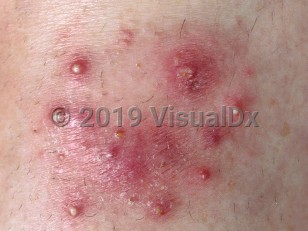Majocchi granuloma in Adult
See also in: Cellulitis DDxAlerts and Notices
Important News & Links
Synopsis

Majocchi granuloma can occur following trauma to the skin or from occlusion of hair follicles. This could be from shaving on the legs as well as the face. Involvement of the buttocks and genital skin has also been reported. The use of topical steroids on unsuspected tinea and immunosuppressed states can also predispose to its development.
This disease is most common in adults between 20 and 35 years old, with a predilection for females. Majocchi granuloma is also more common in females who frequently shave their legs and in those with tinea pedis or onychomycosis.
A deeper and more nodular form of Majocchi granuloma has also been reported in transplant patients and immunocompromised patients. In this cohort, there is a potential for systemic dissemination. Human immunodeficiency virus (HIV)-infected individuals with tinea pedis may have a higher risk of progression to Majocchi granuloma on the feet and lower legs.
Majocchi-like granulomas, deep ulcerated fungal infections, severe tinea capitis and corporis, and fungal nail involvement are characteristic of an inherited deficiency of CARD9 (caspase recruitment domain-containing protein 9), an inflammatory cascade-associated protein. The disorder is autosomal recessive and is most common in North African countries including Algeria, Morocco, and Tunisia. The infections usually begin in childhood and are caused by T rubrum and Trichophyton violaceum. Lymphadenopathy, high IgE antibody levels, and eosinophilia are common, and the disorder can be fatal.
Codes
B35.8 – Other dermatophytoses
SNOMEDCT:
214600002 – Majocchi's granuloma
Look For
Subscription Required
Diagnostic Pearls
Subscription Required
Differential Diagnosis & Pitfalls

Subscription Required
Best Tests
Subscription Required
Management Pearls
Subscription Required
Therapy
Subscription Required
Drug Reaction Data
Subscription Required
References
Subscription Required
Last Updated:03/19/2019


